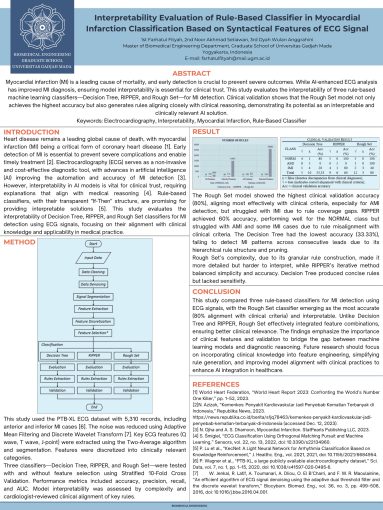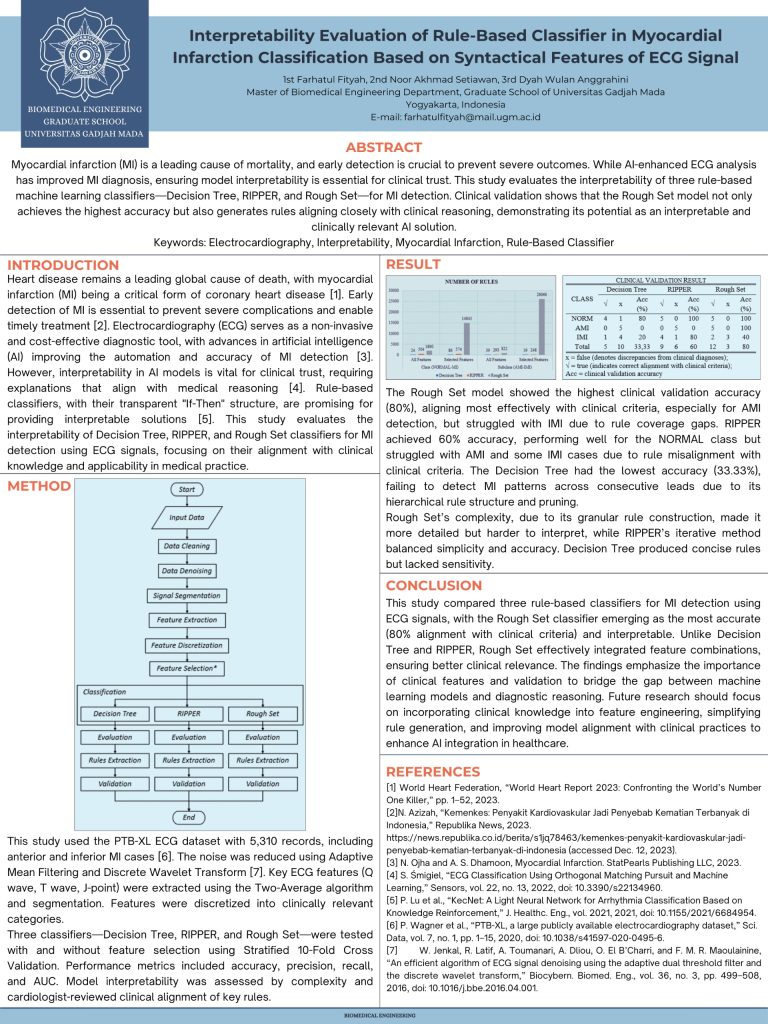

In recent years, heart disease has remained the leading cause of death worldwide, including in Indonesia. Among various heart conditions, myocardial infarction (MI) is one of the most common forms of coronary heart disease. Early detection of MI is crucial to prevent more severe complications, including sudden death. One effective method for detecting myocardial infarction is through the analysis of electrocardiogram (EKG) signals.
The integration of artificial intelligence (AI) technology has significantly advanced the classification of heart diseases based on EKG signals. However, the interpretability of the decision-making results from machine learning models is essential to ensure clinical trust and validity. This research, conducted by Farhatul Fityah, aims to evaluate the interpretability of a simple rule-based machine learning model in the qualitative classification of myocardial infarction by cardiologists.
Farhatul Fityah atau yang akrab disaba Tya adalah Mahasiwa Magister Teknik Biomedis untuk menyusun menjadi sebuah tesis yang bejudul Evaluasi Interpretabilitas Rule-Based Classifier dalam Klasifikasi Myocardial Infarction Berdasarkan Fitur Sintaksis Sinyal EKG, dan berhasil lulus dengan predikat cumlaude pada 31 januari 2025
The study, which took place from January to July 2024 at the Biomedical Engineering Master’s Program at UGM, focuses on comparing the rules generated by different classifiers. The classifiers evaluated include Rough Set, Decision Tree, and RIPPER. The evaluation criteria are based on the complexity of the rules and clinical validation.
The validation process is designed to ensure that the machine’s decision-making aligns with clinical knowledge and medical practices in detecting myocardial infarction through EKG signals. The results of the model evaluation revealed that the Rough Set model achieved the highest accuracy, demonstrating more complex rules compared to the Decision Tree and RIPPER models.
Clinical validation of the rules indicated that the Rough Set model exhibited a dominant classification capability for myocardial infarction, achieving an accuracy rate of 80% when diagnosed based on clinical rules. This finding underscores the importance of interpretability in machine learning models, particularly in the medical field, where trust in technology is paramount.
The implications of this research extend beyond academic interest; they contribute to the broader goals of the Sustainable Development Goals (SDGs), particularly in ensuring access to affordable medicines and education. By improving the accuracy and interpretability of diagnostic tools, healthcare providers can offer better services, ultimately leading to improved health outcomes.
As the research progresses, it is anticipated that the findings will pave the way for more reliable AI applications in cardiology, enhancing the ability to detect myocardial infarction early and accurately. This advancement is crucial in a country like Indonesia, where heart disease remains a significant health challenge.
In conclusion, the evaluation of rule-based classifiers in myocardial infarction classification not only highlights the potential of AI in healthcare but also emphasizes the need for interpretability in machine learning models. This research serves as a stepping stone towards achieving better healthcare solutions and aligns with the global commitment to improving health and well-being for all.


